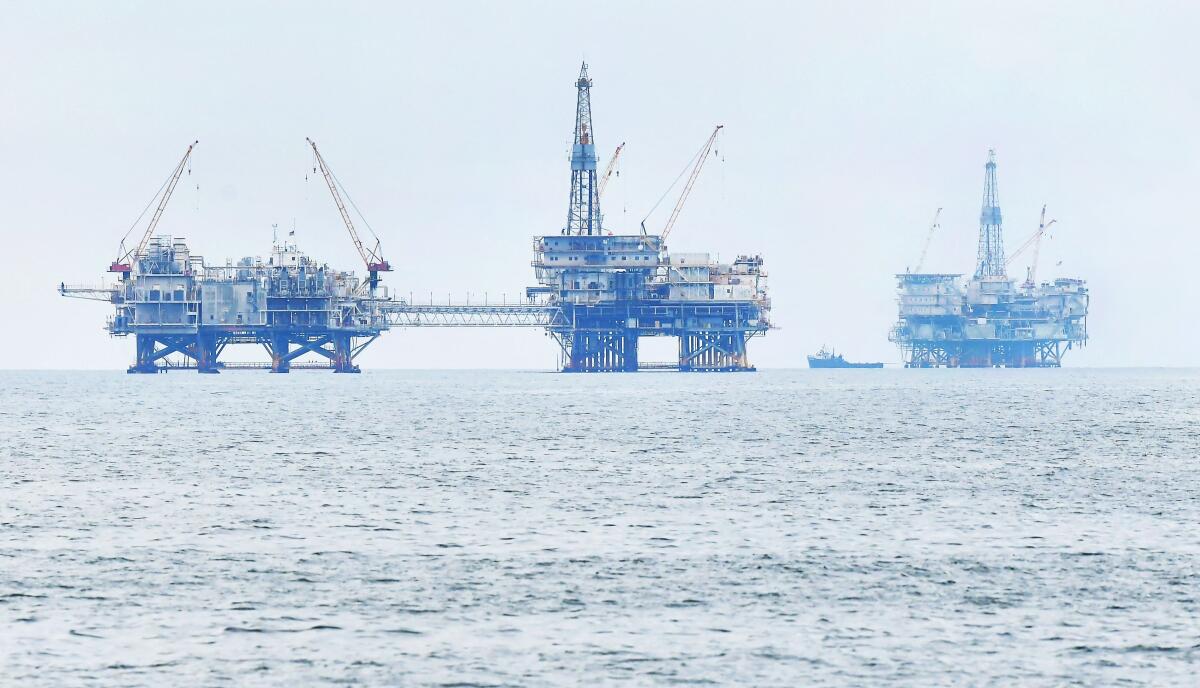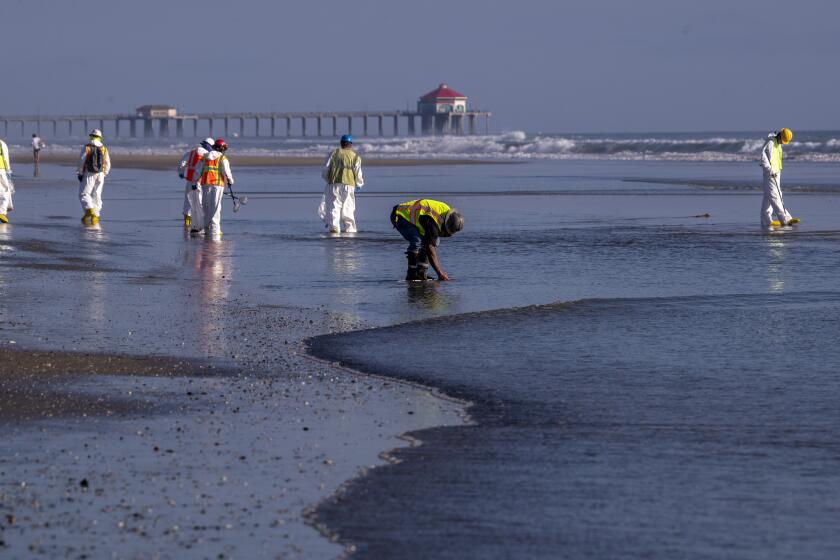How much would it cost to shut down an offshore oil well in California? Who pays?

- Share via
The latest oil spill off the California coast has led some lawmakers and advocates to push not just to extend the ban on new offshore wells, but also to shut down the platforms already operating in state and federal waters.
State and federal officials have the power to force wells within their jurisdictions to cease operating under certain circumstances if needed to protect the public. Doing so would risk provoking a court fight, though, and potentially require a big payout from taxpayers for the platform’s lost earnings.
If an offshore rig does shut down, one thing is clear: The company or companies that held the lease and the rights to operate there are responsible for returning the site to its previous condition.
But it’s also clear that the bonds posted by those companies would cover just a fraction of the cost of decommissioning their wells, pipelines and other structures. Instead, officials are counting on the companies to remain healthy enough to pay the eventual bill.
How much does it cost to decommission a platform?
Many factors are involved, but three big ones are its location (and in particular, the depth of the water there), how old the operation is and whether any underwater structures will be left standing. Both federal and state law allow some platforms’ undersea towers to remain after the platforms are moved, although there is some debate over the safety and environmental impacts of the “rigs to reefs” program.
Aside from removing the underwater structure, the biggest cost is in permanently capping the wells that were drilled. Each oil- and gas-producing platform can be pumping from dozens of wells, their pipes branching off at angles underwater to reach various spots along the leased seabed.
According to a consultant’s report about the platforms in federal waters off the California coast, decommissioning costs there range from $19 million to $189 million per platform. The total cost for Ellen and Eureka, the two drilling platforms near Huntington Beach, and Elly, the associated processing platform, was estimated at $215 million.
Some environmental activists argue that those numbers are too low. The ongoing decommissioning of the Holly platform near Santa Barbara is expected to cost $350 million, and it stands in shallower state waters than the three platforms off Huntington Beach.
The Elly oil platform is a beloved dive site in Southern California. Will the oil spill ruin it forever?
Who pays for decommissioning?
Again, the law and the lease contracts involved are clear: The responsibility for returning a site to its natural state once the platform is abandoned rests with the company holding the lease, along with whoever worked on the site. According to federal regulations, this includes anyone who drills a well, installs a platform or pipeline or holds the rights to operate there.
Federal and state law also give the government the authority to bill previous operators and lease holders in the event that the current ones can’t cover all the costs. They also require lease holders to post bonds, although under federal rules, much of that requirement can be waived for companies that demonstrate sufficient financial strength.
The approach has left taxpayers on the hook for billions of dollars in decommissioning expenses that lease holders and operators should be required to pay, according to a 2016 report from the Government Accountability Office that examined offshore platforms in the Gulf of Mexico. The Interior Department had waived the bond requirement for about $33 billion in projected decommissioning costs, taking on faith that the lease holders and operators would be able to pay them. An additional $2.3 billion in decommissioning liabilities may not have been covered by any form of financial assurance, the GAO said.
Many platforms once operated by major, deep-pocketed energy companies have been sold, and frequently sold again, to smaller operators. This industry undergoes waves of bankruptcies when recessions cause demand to fall and oil prices to plummet. According to the Department of Interior, 30 corporations holding offshore leases have gone bankrupt since 2009.
Again, the government can always try to force the previous lease holders to pay any decommissioning costs the current ones can’t. Federal regulators also have the power to demand more bonds from offshore lease holders and operators as costs go up or financial conditions change. But after the Obama administration sent a notice to lease holders late in 2016 to stiffen the requirement for extra bonds, the Trump administration backed off; it eventually proposed a rule that would reduce the total amount of financial assurance required. That rule is still pending.
Court records from last year indicate that $150 million has been set aside for the decommissioning costs of the three platforms near Huntington Beach, well short of the consultants’ estimated $215 million.
An understanding of the chain of events that led to the Orange County oil spill is playing out like a twist-filled thriller.
Can the government force decommissioning?
Federal law authorizes the secretary of the Interior to suspend and, eventually, cancel an offshore lease or permit in the case of a serious threat to human or aquatic life, property, the environment or national security. But the law also entitles the lease holder to be compensated for lost profits, which could be enormous for a productive well.
“Trying to shut down an existing facility that has its leases and drilling permits is exceedingly difficult,” said Deborah A. Sivas, a professor of environmental law at Stanford Law School. “No facility’s going to take that lying down. There’s a pretty robust takings claim here.”
Within state waters, the California Geologic Energy Management Division “has authority to order any remedial work necessary to prevent damage to life, health, property, or natural resources,” said spokesman Jacob Roper, including suspending production and permanently plugging a well.
Still, the state would face a fight over future earnings if it forced an operator to close a productive platform, Sivas said. And if the state lost that fight, taxpayers would be on the hook to pay for the profits that evaporated.
Officials haven’t approved any new oil exploration off California’s coast in decades. Yet pumping and drilling continue there. Here’s why.










